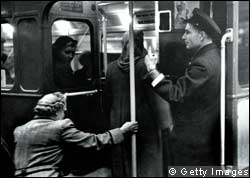The Financial Times recently ran an article about Jerry Morris, a London epidemiologist who did the most famous study of the effect of exercise. He compared London bus drivers with the ticket takers on the same buses. The ticket takers got a lot more exercise than the drivers. The health differences between them were attributed to exercise:
“There was a striking difference in the heart-attack rate. The drivers of these double-decker buses had substantially more, age for age, than the conductors [= ticket takers].” [said Morris]
The data were so telling because drivers and conductors were men of much the same social class. There was only one obvious difference between them. “The drivers were prototypically sedentary,” explains Morris, “and the conductors were unavoidably active. We spent many hours sitting on the buses watching the number of stairs they climbed.” The conductors ascended and descended 500 to 750 steps per working day. And they were half as likely as the drivers to drop dead of a sudden heart attack.
Morris found that bus conductors had fewer heart attacks than sedentary drivers Today, almost everyone understands that physical exercise can help prevent heart disease, as well as cancer, diabetes, depression and much else besides. But on that day in 1949 when Morris looked at the bus data, he was the first person to see the link. He had inadvertently — “mainly luck!” — “ stumbled on a great truth about health: exercise helps you live longer.
It’s not that simple. There are two big confounds in the study (two other differences between drivers and ticket takers) that surely caused Morris to overestimate the benefits of exercise. One is well-known to epidemiologists: Bus driving is very stressful. Much more stressful than a dozen other equally sedentary jobs. Stress certainly causes heart disease. The other is based on my discovery that standing a lot improves sleep. (The standing needn’t involve movement.) I don’t know if better sleep specifically reduces heart disease but it certainly increases resistance to infection and heart disease seems to have an infectious component. The ticket takers were on their feet all day, the drivers were not.
You may remember that James Fixx, a famous advocate of jogging, died of a heart attack.
Thanks to Dave Lull.

I was thinking of those confounding factors while reading your blog, too. I thought of one more that I’m surprised you didn’t mention: seeing faces/social interaction.
Bus drivers are notoriously asocial (at least all the ones I’ve encountered were). They generally don’t even make eye contact with passengers getting on and off the bus (except when looking in their rear-view mirror). The ticket collectors, on the other hand, were engaged in highly social interactions. Even if they only actually talked to one out of every 10 or 20 or 50 passengers, that would be quite a bit of social interaction for a day.
This blog brings to mind Taleb’s statement about how much things we don’t see matter just as much as, if not more than, things we do see. The researchers (and journalists reporting on the research, and readers reading the media reports on the research) all see the difference in activity, but they don’t even consider all of the co-varying factors that could also account for some or all of the differences in measured effects (in this case heart attacks).
Good point, Aaron.
Just last week I had read about studies of bus drivers and hypertension, work by Berkeley’s Lenonard Syme, that highlights those confounding factors. Here’s a brief excerpt:
Syme points to his study of hypertension
in San Francisco bus drivers as an
example of how easy it is to miss the
forest for the trees. While investigating
the unusually high rates of hypertension
in this group, the research team found
that bus drivers also complained of back
pain and gastrointestinal and respiratory
difficulties. The team designed interventions
to address these issues, but none
were effective. Then the researchers
learned more about the bus drivers’
daily routine. Drivers had to adhere to a
rigid schedule that was determined by
a computer, and they were penalized
for late arrivals. However, there was a
shortage of buses, which meant drivers
often were not given enough time to
get from one stop to the next. They
raced into fast food restaurants for
meals to stay on schedule. Because
they were so often late, they faced irate
passengers and traffic problems daily,
and often did not have time to return
home between morning and evening
shifts. The problem, says Syme, was
that the researchers were focusing on
the specific diseases rather than the
fundamental problem: the job.
It was from Syme that I learned about the stressful lives and special health problems of bus drivers.